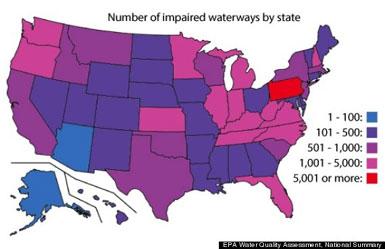WASHINGTON – Millions of Americans are unwittingly drinking water that includes an invisible toxic cocktail made up of contaminants linked to cancer, brain damage and other serious health harms, the 2021 update to the Environmental Working Group’s nationwide Tap Water Database reveals.
The one-of-a-kind comprehensive consumer tool uncovers widespread contamination from toxic substances such as arsenic, lead and the “forever chemicals” known as PFAS in the drinking water of tens of millions of households in all 50 states and the District of Columbia.
The database also underscores the need for stricter federal water quality standards and a massive injection of funding for badly needed water infrastructure improvements across the country.
“EWG’s Tap Water Database offers a panoramic view of what drinking water quality looks like when the federal office meant to protect our water is in an advanced stage of regulatory capture,” said EWG President Ken Cook.
“The Environmental Protection Agency’s Office of Groundwater and Drinking Water has demonstrated for decades that it is utterly incapable of standing up to pressure from water utilities and polluters to protect human health from the dozens of toxic contaminants in America’s drinking water,” Cook said.
To create the Tap Water Database, EWG’s researchers and scientists spent countless hours over more than two years collecting and analyzing U.S. water contaminant test data from almost 50,000 water systems.
Consumers can enter a ZIP code into the database and see a report of the type and amount of toxic chemicals detected in that location’s drinking water. They can also see safety assessments developed by EWG scientists about the adverse health effects associated with exposure to those contaminants.
The U.S. tap water system is plagued by antiquated infrastructure and rampant pollution of source water, while out-of-date EPA regulations, often relying on archaic science, allow unsafe levels of toxic chemicals in drinking water.
Substantial federal investments that could do a great deal to solve many U.S. tap water problems, like removing toxic lead service lines and cleaning up PFAS contamination, are at stake this fall, as Congress debates massive infrastructure spending bills.
“With more funding, stronger federal safety standards and a greater focus on helping historically disadvantaged areas, safe water could finally be a given for all communities across the country,” Cook said. “Until then, EWG’s Tap Water Database will continue to be a key part of our work to help consumers and communities learn about the true scope of the problem, empower themselves and advocate for better water quality.”

The Tap Water Database also explains the standards that EWG has created for several tap water contaminants, drawing on the latest science to address the gap in federal oversight and better protect public health. And the database provides guidance about choosing effective water filters to reduce the pollutants found in consumers’ drinking water.
“Our government needs to wake up to the fact that clean water is a human right, regardless of race, income or politics,” said noted consumer advocate Erin Brockovich. “Achieving true water equity means getting everyone – every single person – in this country access to affordable, safe tap water they can trust will not poison them and their loved ones.”
In 1974, the Safe Drinking Water Act gave the EPA the responsibility to oversee tap water quality across the U.S. Over the next 47 years, the agency has set maximum contaminant levels, or MCLs – the upper limit of a pollutant legally allowed in drinking water – for more than 90 contaminants.
The water provided by most systems is considered legal according to these limits – but it is hardly safe. In fact, federal oversight of drinking water has been failing for years.
“The EPA has become very good at constantly reassuring the public that all is well with the water coming out of their taps,” Cook said. “That message is music to the ears of polluters who’ve fouled source waters and water utilities wary of treatment and infrastructure costs. But it’s just not true – and the EPA’s own scientists know it.”
This is the true state of tap water regulation in the U.S.:
EWG's Guide to Safe Drinking WaterReduce your exposures to common drinking water pollutants with EWG's handy tipsheet!
For anyone suffering from polluted drinking water, the lax federal regulation of our vital drinking water, combined with the important findings of the Tap Water Database update, serve as a call to action to push for stricter policies and funding hikes.
“Whether it is lead in Flint, Michigan, or in many other cities, or perchlorate, PFAS or hexavalent chromium in the water of hundreds of millions of Americans nationwide – the list goes on and on – the EPA consistently fails to take urgent, meaningful regulatory action, not even in the many instances when contamination is above levels the agency’s own scientists have determined are not safe,” Cook said. “The Tap Water Database makes these failings abundantly clear.”
Access to safe tap water is a non-partisan issue. And oversight failures at the EPA have spanned both Republican and Democratic administrations. Cook is calling on agency officials who have pushed for stricter rules but been overruled about speaking out.
“There are thousands of current and former hardworking career staff at the EPA’s Office of Water who have tried to get their agency to act but been rebuffed by political leadership," Cook said. “I urge them to contact EWG, lawmakers or the press to blow the whistle on these decades of failure when it comes to the agency’s responsibility to protect tap water.”
###
The Environmental Working Group is a nonprofit, non-partisan organization that empowers people to live healthier lives in a healthier environment. Through research, advocacy and unique education tools, EWG drives consumer choice and civic action. Visit www.ewg.org for more information.









